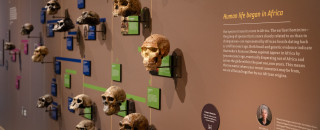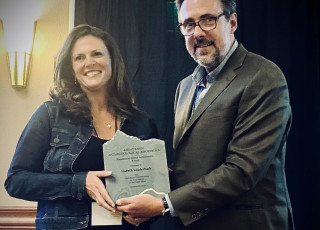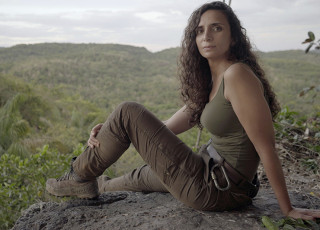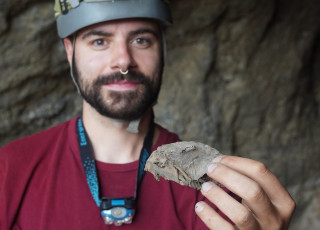What Makes Us Human?
By Megan R. Bartley, J. Tyler Faith, and Kristen Hawkes.
There are now more than 8 billion people on the planet. We live on all continents, in all kinds of environments, and we have transformed the world around us. How did we get to this point? Why are we so different from our closest living relatives, the chimpanzees and bonobos? And more broadly, what makes us human?
The characteristics of all living things result from the pressure of natural selection on their ancestors as they confronted challenges to their survival and reproduction. This fundamental Darwinian insight applies to us. Long before the split between human and chimpanzee lineages, around 8 million years ago, tropical Africa was dominated by forests. The Serengeti-like savannas that we are familiar with today—the open grasslands dotted with Acacia trees and home to large herds of zebras, wildebeest, and gazelles—did not exist. But over millions of years, Africa’s climate became cooler and drier, leading to the fragmentation of tropical forests and the expansion of savannas. Understanding how our ancestors adapted to these environmental changes is critical to understanding what makes us human.
While the ancestors of chimpanzees and bonobos remained in forests, some members of that ancestral population were lured by opportunities in savanna ecosystems. Of those that were lured, some became our own genus, Homo, setting us on the path to where we are today. How did these novel environments help make us human? One well-known idea, the hunting hypothesis, is that we became human by colonizing the expanding savannas to hunt large game. This idea seemed consistent with archaeological evidence of stone tools alongside butchered animal bones. It also seemed consistent with ethnographic findings of pair bonds in modern communities where people still rely on wild foods, with men typically hunting big game and women generally gathering plant foods. In this account, ancestral males hunted and brought meat home to their mates and offspring, supporting nuclear families that could have more children. In turn, reliance on big game hunting and stone tools favored the development of complex skills, and larger brains that improved hunting success and eventually propelled our complex social systems. But accumulating evidence is challenging this long-standing narrative.
One significant challenge to the hunting hypothesis arose from anthropologist Kristen Hawkes and her research group living with Aché hunter-gatherers in Eastern Paraguay. Kristen's team found that, contrary to expectations, men passed up opportunities to obtain food for their own wives and kids in favor of bigger animals the entire community consumed. This was not consistent with the notion that hunting was all about providing food for the hunter’s own family. In another study with Hadza foragers in northern Tanzania, situated at the edge of the Serengeti where much bigger herbivores and their carnivore predators still persist, men focused on hunting these animals and aggressively taking carcasses from competing carnivores. Successes were a bonanza, with everyone in the community enthusiastically claiming their share of the meat. There was no special share for the hunters’ own family and, even though men went hunting every day, often weeks would pass between successful kills.
The unpredictability of meat and the tendency to share it broadly pose a problem for the hunting hypothesis. Our chimpanzee and bonobo cousins start picking their own food before their first birthday, and feed themselves independently by the time they are weaned. In contrast, human babies wean much earlier and develop more slowly, so they have to be fed by someone else long after they stop nursing. Our slower development and earlier weaning could only be favored by natural selection if there were a reliable source of food. Results from the Hadza studies demonstrated that big game hunting carried a high risk of failure, making it too unreliable to meet the daily needs of growing children—or anyone else. So, if not meat, then what?
The day-to-day Hadza diet is mostly plant foods, with women dependably digging up the year-round staple: deeply buried tubers. Extracting these tubers requires size and strength that small children lack. The Hadza community welcomed Kristen and her colleagues to count the time everyone spent in different activities, following forays out of camp and weighing foods acquired. Folks also agreed to be weighed themselves. Initially, the weight of young children aligned with their mother's foraging productivity, but this correlation disappeared when mom had a new baby. Then, the weight changes of these children, a good indicator of how well they were fed, tracked the foraging productivity of their grandmothers. These findings are one line of evidence supporting an alternative hypothesis about how life in the savannas may have helped make us human.
The Grandmother Hypothesis
Imagine a population of apes foraging in a novel environment—the savannas of Africa. Adults discover they can obtain plenty of food by focusing on plants that evolved to survive the dry season by encasing their seeds in hard outer shells, or storing water and starches in roots underground. However, in this new savanna environment, little apes lack the strength and size to acquire these foods, so they are dependent on others to feed them. Someone needs to be feeding these savanna children—and the lessons from modern people who know how to solve that problem point to a key role for grandma.
In ancestral apes, female fertility probably ended before the age of fifty, as it does in us and other apes today. Other apes become frail and vulnerable to mortality in their thirties, and usually die during their fertile years. In contrast, women are unique compared to other apes, remaining healthy and productive long after their fertile years. Why might this be? Recall the Hadza studies showed that grandmothers are critical to feeding their weaned grandchildren, in turn freeing up mother to have another child sooner. If grandmothers in this ancestral ape population were able to share foods that their grandchildren could not easily get themselves, there would be evolutionary benefit to doing so in the form of more grandchildren. This would also drive selection for longer-living grandmothers because those that live longer leave more descendants. Consequently, shorter birth intervals, slower aging, and lower adult mortality would increase in the generations that followed. These life history shifts could account for the evolution of many features that distinguish us from other living apes.
The combination of prolonged immaturity with shorter birth intervals meant that ancestral human infants lost their mother’s undivided attention long before they reach independence. This major shift in early-life environment put strong selective pressure on otherwise helpless babies’ own capacities and tendencies to engage protection and support. It prioritized sensitivity to social connections and relationships during the early wiring of our slowly maturing baby brains, resulting in enduring appetites for mutual understanding and responsiveness to social contexts throughout our lives.
Increased longevity in our ancestors had another major consequence, as the increase in post-menopausal females was mirrored by an increase in older, still-fertile males. That meant more fertile males than females, which is rare among mammals, including chimpanzees and bonobos. A male bias is common in birds where competition among males for a smaller pool of females makes claiming a mate and guarding her the strategy that gets males the most offspring. Ancestral human males who found a mate and guarded their claim to her, forming a pair bond, left more descendants than those who continually pursued new mating opportunities, as is typical of the chimpanzee lineage.
This difference in mating strategies links to a question left by ethnographic evidence that hunting big animals is not an effective way to support a hunter’s wife and kids. If it doesn’t serve that goal, why is it so widespread? Why do men hunt? When pair bonding is favored by intense competition for mates, males that earn respect from their peers gain deference to their claims on a mate. High-risk behaviors, like hunting big game or forcefully taking kills from hungry predators would have gained respect among males in ancestral communities—much as it does in contemporary foraging societies where successful hunts are celebrated and consumed by the entire community. Older men with superior hunting reputations keep younger rivals from claiming young women. In contrast, chimpanzee males compete more strongly for chances to mate with older females. The reputation benefits earned by good hunters among living people that depend on wild foods point to big game hunting as male competition for social standing that pays off in mating claims. From this perspective, ancestral hunting didn’t drive evolution of the unique traits that make us human; rather, it’s among the consequences of the life history shifts that arose from grandmothering.



